Instructional Series
This site will be closing soon as its content has moved to Tāhūrangi.
2024 titles are available on Tāhūrangi. Use the filters to find specific series.
Find Literacy resources at Tāhūrangi - Literacy.
Welcome to the English medium literacy instructional series teaching and learning resources for years 1 to 8.
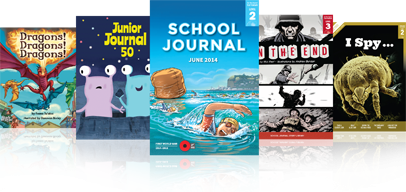
- Gold
- Purple
- Magenta
- Yellow
- 3
- 4
- 2
- 1
- 6
- 4
- 5
- 8
- 7
- 3
- 1
- English
- Social Sciences
- Science
- Health and Physical Education
- Technology
- Mathematics and Statistics
- The Arts
- Non-fiction
- Fiction
- None
- Nature of science
- Geometry and Measurement
- Living world
- Planet Earth and beyond
- Nature of technology
- Physical world
- Number and Algebra
- Statistics
- Technological knowledge
- Material world
- Technological practice
- Engage with science
- Gather and interpret data
- Interpret representations
- Use evidence
- Articles
- Stories
- Poems
Search results
166 items - Showing 71 - 80
-
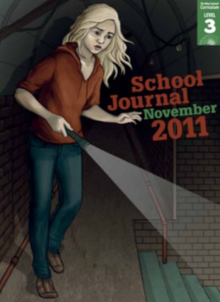
Timber!
by Jullia Wall
This article describes how trees have been used in New Zealand and the impact people have had on the native forests. The text shares the perspectives of people involved in the timber industry and of conservationists since the arrival of European settlers. It outlines the events that occurred, the resulting impact on indigenous forests, and the steps taken to sustain them.
-
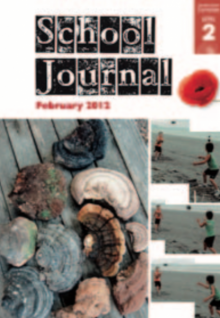
The Anzac Button
by Judy Raymond
This is the story of a button that was sewn onto the jacket of a First World War soldier. After the war, the soldier returns to New Zealand and wears the jacket to annual Anzac Day parades. Many years later, Ella, the soldier’s great-granddaughter, discovers the jacket. She sews the button onto a ribbon and proudly wears it to another Anzac Day parade. The story ends with a factual note about the meaning of Anzac Day.
-
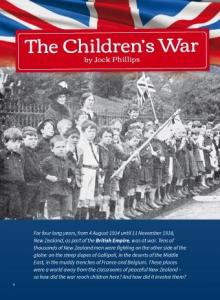
The Children’s War
by Jock Phillips
After a general introduction and overview of the First World War, the article describes how the New Zealand government used a variety
of methods to encourage children to support the war effort. One method was to use the School Journal to give children positive stories
(avoiding the harsher realities) and articles about exemplary “Empire heroes”. -
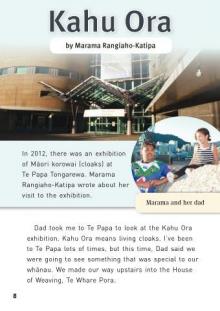
Kahu Ora
by Marama Rangiaho-Katipa
This is a recount of a visit to the exhibition of Kahu Ora (living cloaks) at Te Papa Tongarewa, the Museum of New Zealand. In the exhibition, there is one korowai that has a special significance to Marama, the author. She learns about how korowai are made and how a special korowai reveals a story from her iwi.
Gold 1
-
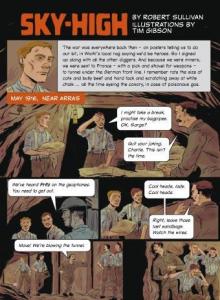
Sky-high
By Robert Sullivan
Illustrations by Tim Gibson
Beneath the town of Arras, on the Western Front, it’s a race against time.
Information and tips for using comics in the classroom: -
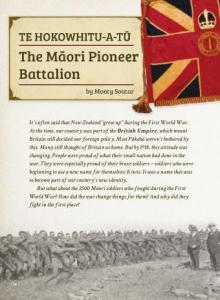
Te Hokowhitu-a-Tū: The Māori Pioneer Battalion
by Monty Soutar
This article tells the story of Māori and the First World War and of the huge contribution made by the pioneer Māori Battalion. The topic will be unfamiliar for many students, but the themed content in the surrounding items will provide support.
-
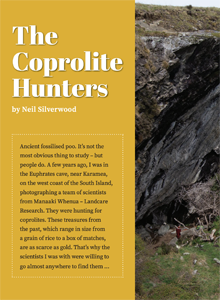
The Coprolite Hunters
by Neil Silverwood
Photographer Neil Silverwood has documented the work of New Zealand scientists before. This time, they’re hunting for coprolites – fossilised animal faeces. Analysing this “treasure from the past” allows scientists to learn more about our endangered native bird species, including the kinds of habitats that once supported them. This is another useful article about the work scientists do and the many ways in which they continue to learn about our world.
-
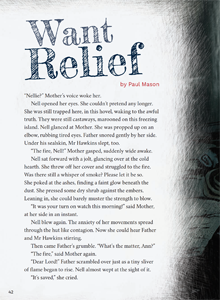
Want Relief
by Paul Mason, illustrations by Andrew Burdan
The Auckland Islands, a New Zealand territory in the Southern Ocean, were the site of nine shipwrecks in the nineteenth century. Paul Mason uses this as a starting point for his fictional story about Nell, who becomes a castaway with several others and must play her part in keeping their precious fire going.
-
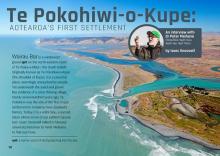
Te Pokohiwi-o-Kupe: Aotearoa’s first settlement
An interview with Dr Peter Meihana (Rangitāne, Ngāti Kuia, Ngāti Apa, Ngāi Tahu) by Isaac Snoswell
Wairau Bar is one of the earliest settlement sites in Aotearoa New Zealand. Seven hundred years ago, it was home to at least two hundred people, serving as a hub for trade, celebrations, ceremony, and community. This interview with Dr Peter Meihana explores who lived there, when they arrived, where they came from, what the settlement was used for, and how we know this.
-
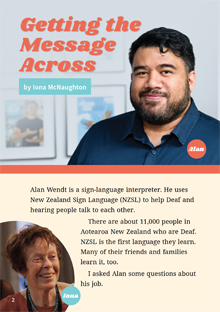
Getting the Message Across
by Iona McNaughton
In this interview, Iona McNaughton talks to Alan Wendt, a New Zealand Sign Language interpreter. Alan explains why he chose to become an interpreter and describes what his job involves. “Getting the Message Across” is one of several pieces in this journal on the theme of communication.
Gold 1







 Literacy Online home
Literacy Online home
